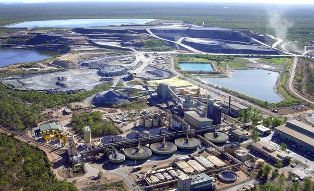Energy Resources of Australia (ERA) has announced the definition of a significant mineral exploration target adjacent to its Ranger 3 pit in Australia's Northern Territory.
 |
| The processing plant at Ranger (Image: ERA) |
The mineralised zone has a strike length so far identified of about 1.2 km, between 250 metres and 550 metres from the surface and it has been intersected by 110 drill holes, immediately east of the pit. Grades range up to 1% uranium oxide over 20 metres. The Deeps might become an extension to the open pit, or be a new underground mine.
ERA is continuing to drill on this target during the fourth quarter of 2008, focused on extending knowledge to the northern end of the deposit mineralisation, and in developing sufficient data to define a mineral resource in accordance with Joint Ore Reserves Committee (JORC) standards.
The company has also been commissioning its laterite treatment plant, built to treat 1.6 million tonnes of stockpiled ore with too high a clay content to be used without this pre-treatment. The A$44 million ($28.5 million) plant is expected to add 340 tU/yr to production for seven years. ERA is also commissioning a new A$19 million ($12.3 million) radiometric ore sorter, which will increase the head grade treated by the main plant and bring forward production of 930 tonnes of uranium over four years via grade manipulation.
A feasibility study into a major heap leach operation for low-grade ore is under way, with prospect of recovering up to 17,000 tonnes of uranium. Trials in leach columns have been encouraging.
In 2007, ERA approved an extension to the operating pit at Ranger, enabling mining to continue until at least 2012. Ranger was the world's second highest producing uranium mine in 2007, when its output of 4589 tU represented 11% of world production.





_69614.jpg)

_15447.jpg)




